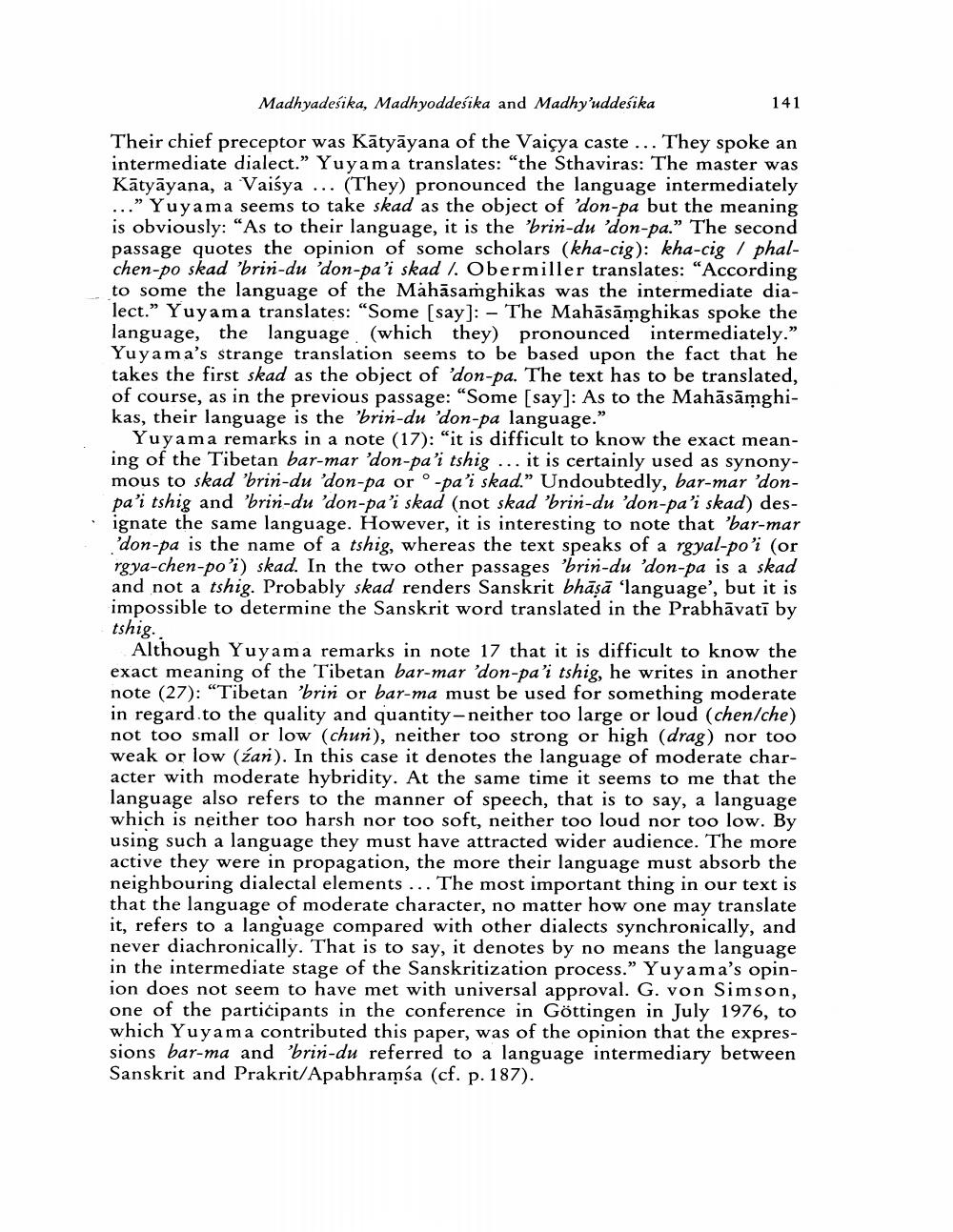Book Title: Madhyadesika Madhyoddesika And Madhyuddesika Author(s): J W De Jong Publisher: J W De Jong View full book textPage 4
________________ Madhyadesika, Madhyoddesika and Madhy'uddesika 141 Their chief preceptor was Kātyāyana of the Vaiçya caste ... They spoke an intermediate dialect.” Yuyama translates: "the Sthaviras: The master was Kātyāyana, a Vaisya ... (They) pronounced the language intermediately ...” Yuyama seems to take skad as the object of 'don-pa but the meaning is obviously: "As to their language, it is the 'brin-du 'don-pa.” The second passage quotes the opinion of some scholars (kha-cig): kha-cig / phalchen-po skad 'brin-du 'don-pa'i skad I. Obermiller translates: “According to some the language of the Mahāsamghikas was the intermediate dialect.” Yuyama translates: “Some (say]: - The Mahāsāmghikas spoke the language, the language (which they) pronounced intermediately." Yuyama's strange translation seems to be based upon the fact that he takes the first skad as the object of 'don-pa. The text has to be translated, of course, as in the previous passage: “Some [say]: As to the Mahāsāmghikas, their language is the 'brin-du 'don-pa language.” Yuyama remarks in a note (17): “it is difficult to know the exact meaning of the Tibetan bar-mar 'don-pa'i tshig ... it is certainly used as synonymous to skad 'brin-du 'don-pa oro-pa’i skad." Undoubtedly, bar-mar 'donpa’i tshig and 'brin-du 'don-pa'i skad (not skad 'brin-du 'don-pa’i skad) designate the same language. However, it is interesting to note that 'bar-mar 'don-pa is the name of a tshig, whereas the text speaks of a rgyal-po'i (or rgya-chen-po'i) skad. In the two other passages 'brin-du 'don-pa is a skad and not a tshig. Probably skad renders Sanskrit bhāṣā "language', but it is impossible to determine the Sanskrit word translated in the Prabhāvatī by tshig. Although Yuyama remarks in note 17 that it is difficult to know the exact meaning of the Tibetan bar-mar 'don-pa’i tshig, he writes in another note (27): "Tibetan 'brin or bar-ma must be used for something moderate in regard to the quality and quantity-neither too large or loud (chen/che) not too small or low (chun), neither too strong or high (drag) nor too weak or low (zan). In this case it denotes the language of moderate character with moderate hybridity. At the same time it seems to me that the language also refers to the manner of speech, that is to say, a language which is neither too harsh nor too soft, neither too loud nor too low. By using such a language they must have attracted wider audience. The more active they were in propagation, the more their language must absorb the neighbouring dialectal elements ... The most important thing in our text is that the language of moderate character, no matter how one may translate it, refers to a language compared with other dialects synchronically, and never diachronically. That is to say, it denotes by no means the language in the intermediate stage of the Sanskritization process." Yuyama's opinion does not seem to have met with universal approval. G. von Simson, one of the participants in the conference in Göttingen in July 1976, to which Yuyama contributed this paper, was of the opinion that the expressions bar-ma and 'brin-du referred to a language intermediary between Sanskrit and Prakrit/Apabhramsa (cf. p. 187).Page Navigation
1 2 3 4 5 6
